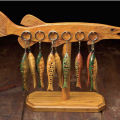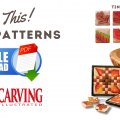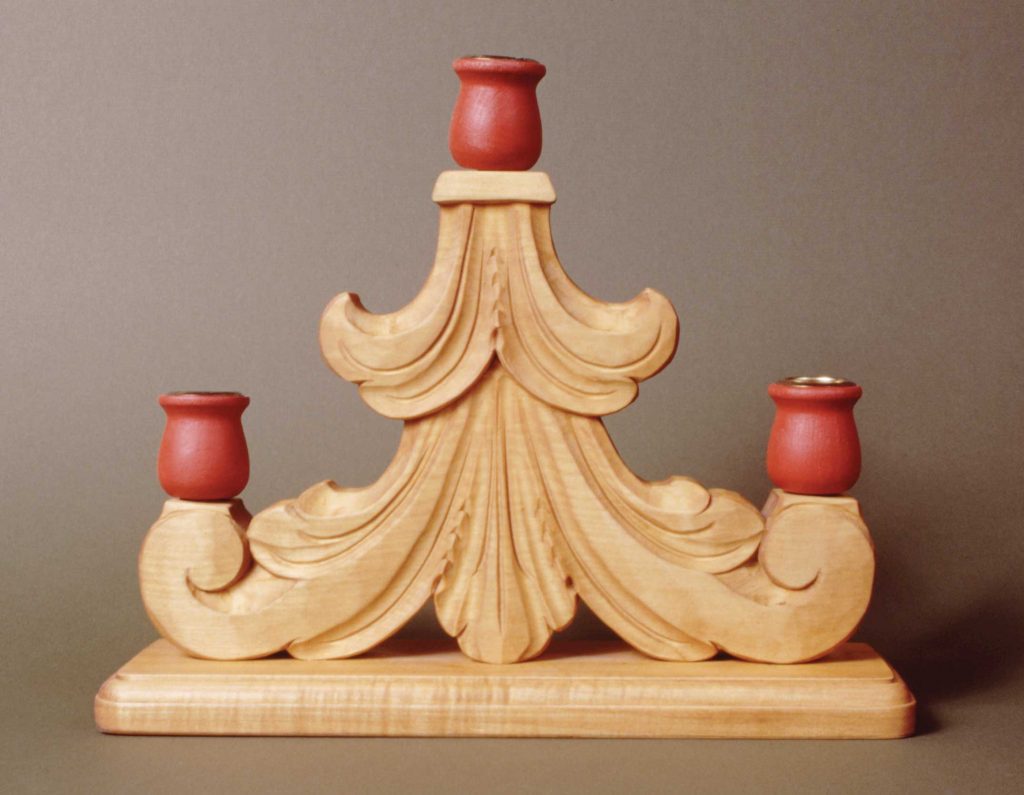 A project to Brighten Your Evening
A project to Brighten Your Evening
By Phillip Odden
As the seasons change and the weather gets colder, my wife and I spend more time inside. With fewer hours of daylight, a nicely carved candle holder makes a room feel cozy during the evenings. The carving can grace a dining table as a centerpiece when not in use, and during the holiday season the base lends itself to decorations such as green pine boughs with red Christmas tree ornaments.
The term acanthus describes the classical leaf elements used in designs that originated with the ancient Greeks in the Mediterranean regions. It has persisted and evolved throughout history, returning most notably during the baroque period in central Europe during the 17th century. The acanthus style that I carve is from Norway where it is still prevalent.
To help you understand the carving of the candle holder, let me define the terms that most often describe the anatomy of the acanthus. Made up of leaves, the acanthus has lobes or projections. Usually there is a large, dominant lobe with one to three minor lobes. Scroll describes a flowing and curving leaf configuration. Eyes are oval-shaped and occur at the juncture of two scroll configurations and are often accented with three checks. The check closest to the eye is the largest and the others diminish in size. Veins are accent lines and, like checks, are done at the end of the carving process. Made with a V-tool, veins help accentuate the flow of acanthus scrolls and leaves. A properly formed vein is deeper and wider at the terminus or growing end of the leaf or scroll and diminishes in width and depth as the leaf narrows.
If there is a trick to carving acanthus leaves, it is to have the gouge cuts look as if they are made in one motion. In reality, this is not possible. It takes several cuts with each gouge to create a leaf that has a smooth flow. A certain amount of skill is involved in having the cuts match up so that the unwanted textures are minimized.
Another “secret” to carving acanthus leaves is sharp tools. If the tools are finely honed, they will leave burnished surfaces. Sandpaper should never be used as it dulls and defaces the surface by removing lines that delineate the leaves.
Northern-grown basswood is my wood of choice. It carves more easily than wood that originates in coastal areas or areas with low elevations and temperate weather. I prefer air-dried lumber to kiln dried because it is easier to work. While the basswood base for the candle holder is not carved, a routed edge is appropriate to dress it up.
This project has the same carving pattern on both sides, with the same leaf pattern repeated four times, one side being the mirror image of the other.
Once the project is carved and routed, I stain it with a water-soluble aniline dye. My choice is Homestead Light Oak available from Woodcraft. I mix the dye with water, let it stand, and then mix it again to make sure that all the powder is in the solution. For the stain to be effective, the entire wood surface must be saturated. After letting the wood dry overnight, I use a Danish oil finish. When the oil is dry, I lightly coat the wood with wax. I prefer Briwax because it provides a low-luster sheen.
The candle cups can be purchased at most hobby stores. To brighten up the piece, I paint the cups with red acrylic paint and then glue them in place. Once the base is screwed to the carving, I set out to find myself some attractive candles and wait for a winter evening to enjoy my work.
Materials:
Basswood: 1 1/8″ x 7 1/2″ x 12″ (29mm x 19.1cm x 30.5cm) (candle holder)
Basswood: 3/4″ x 3 1/4″ x 12″ (19mm x 83mm x 30.5cm) (base)
Water-soluble aniline dye, such as Homestead Light Oak
Danish oil
Wax
Tools:
#3, #5 gouges: 14mm
#8 gouge: 9mm
#8 gouge: 16mm
Skew chisel: 20mm
#12 V-tool: 5mm
Bench knife
CLICK HERE to view the candle holder pattern.
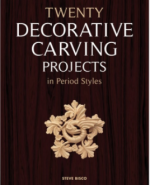
For further information on decorative woodcarving read Twenty Decorative Carving Patterns by Steve Bisco. Woodcarvers of all abilities will develop new skills, as well as gain an understanding of various carving styles as they evolved through history. It is available for purchase from www.foxchapelpublishing.com for $24.95 plus S&H.
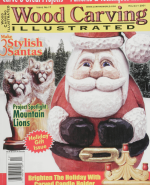 This article first appeared in Woodcarving Illustrated Holiday 2001 (Issue 17). Other issues of Woodcarving Illustrated are available for purchase from www.foxchapelpublishg.com.
This article first appeared in Woodcarving Illustrated Holiday 2001 (Issue 17). Other issues of Woodcarving Illustrated are available for purchase from www.foxchapelpublishg.com.



